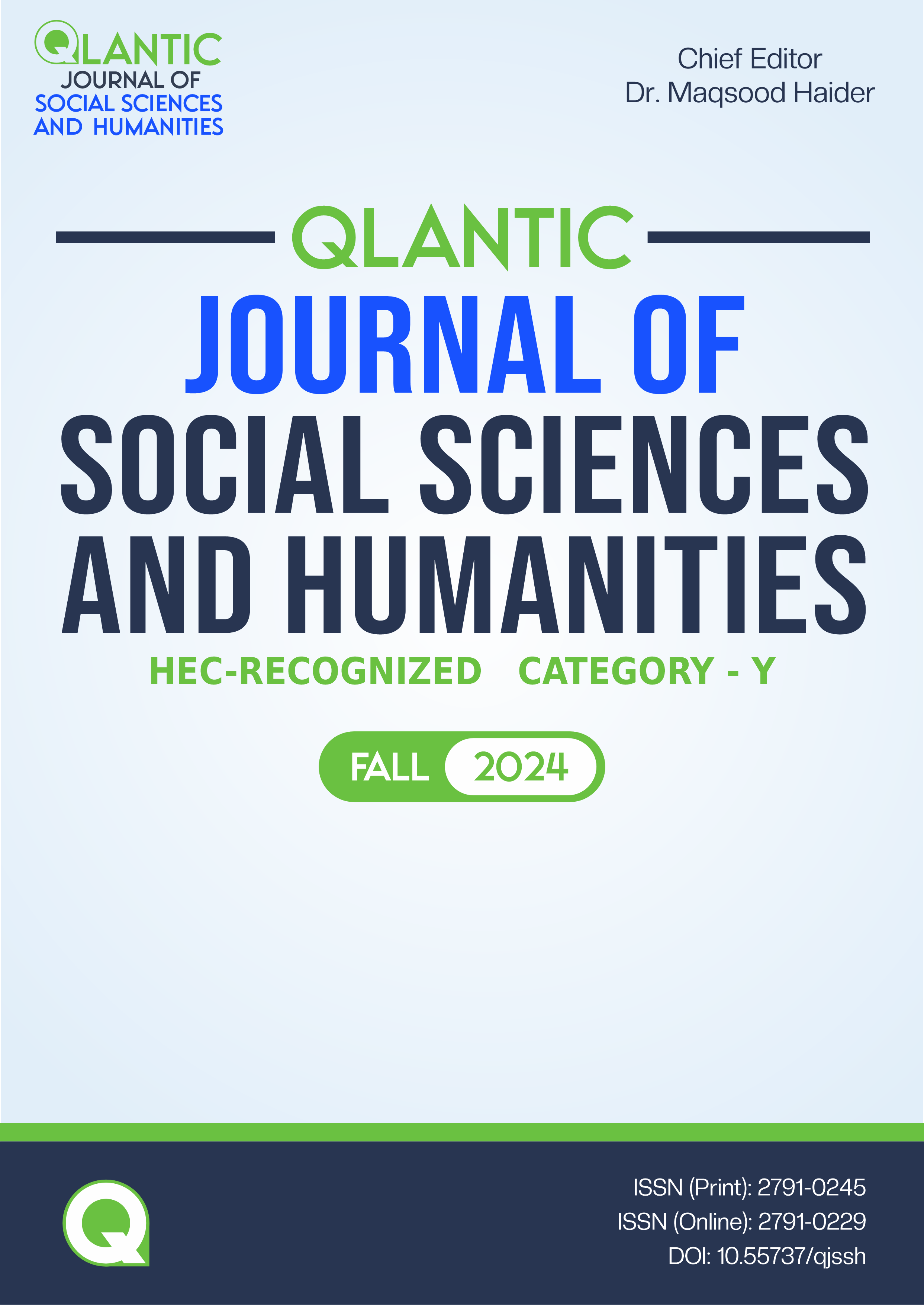Early Marriage Brides; Survival Tactics of Young Brides within their In-Laws Families: A Case of Pakistan
DOI:
https://doi.org/10.55737/qjssh.113553557Keywords:
Young, Education, Early Marriage, Livelihoods, Survival, In-LawsAbstract
One of the many social structures created to regulate and control human life is marriage. It is the accepted social model in which a family is formed by at least two individuals. However, a marriage that does not follow the traditional path or that disregards fundamental human rights standards raises fundamental social difficulties with complex consequences. The present examination explores different causes and results of early marriage in Pakistani society. The aim to acquire or maintain power and control over a personal conflict is characterized by harsh conduct, such as aggressive behavior at home. Aggressive behavior reception and psychological pattern square measure practices utilized by one individual in a relationship to manage the opposite place or other relatives. This research study was conducted in Layyah, Punjab, Pakistan. For data collection, a specific range of people were targeted to get the best results, and then SPSS was used to analyze the data. Mostly, young brides were not in favor of early marriage. They said that in early marriage, they have to face many social, economic, psychological, and physical problems. They said they were not ready to hold this kind of responsibility at a young age.
References
Ahmed, S., Khan, S., Alia, M., & Noushad, S. (2013). Psychological Impact Evaluation of Early Marriages. International Journal of Endorsing Health Science Research (IJEHSR), 1(2), 84–86. https://doi.org/10.29052/ijehsr.v1.i2.2013.84-86
Ali, P. A., & Gavino, M. I. (2008). Violence against women in Pakistan: a framework for analysis. The Journal of the Pakistan Medical Association, 58(4), 198–203. https://www.archive.jpma.org.pk/article-details/1372
Ayotola, K. K., & Karim, Z. A. (2015). Socio-Religious and Socio-Cultural Perspectives of Delayed Marriage. Academic Research International, 6(2), 210-221.
Bajracharya, A., & Amin, S. (2012). Poverty, marriage timing, and transitions to adulthood in Nepal. Studies in family planning, 43(2), 79-92. https://doi.org/10.1111/j.1728-4465.2012.00307.x
Briere, B., Hallman, K., & Quisumbing, A. R. (2003). Resource allocation and empowerment of women in rural Bangladesh. Household decisions, gender, and development: A synthesis of recent research, 89-93.
Daraz, U., Naz, A., & Khan, W. (2014). Early Marriage: a developmental challenge to women in Pakhtun Society. FWU Journal of Social Sciences, 8(1), 91-96. http://sbbwu.edu.pk/journal/FWU_Journal_Summer2014,Vol.8,No.1/14_Early_Marriage_A_Developmental_Challenge_(revised).pdf
Dhital, R. (2000). Child marriage in Nepal. https://www.wvi.org/sites/default/files/Child%20Marriage%20in%20Nepal-%20Report.pdf
Fikree, F. F., Jafarey, S. N., Razia Korejo, Anjum Afshan, & Durocher, J. M. (2006). Intimate partner violence before and during pregnancy: experiences of postpartum women in Karachi, Pakistan. PubMed, 56(6), 252–257. https://citeseerx.ist.psu.edu/document?repid=rep1&type=pdf&doi=8f63f92f5234a59091a0c67eea06a14b8b2ae9f2
Fussell, E., & Palloni, A. (2004). Persistent marriage regimes in changing times. Journal of Marriage and Family, 66(5), 1201–1213. https://doi.org/10.1111/j.0022-2445.2004.00087.x
Gangadharan, L., & Maitra, P. (2000). The effect of education on the timing of marriage and first conception in Pakistan. Monash University.
Gupta, P. (2012). Child Marriages and the Law: Contemporary Concerns. Economic and Political Weekly, 47(43), 49–55. https://www.jstor.org/stable/41720300
Hallaq, W. B. (2009). Sharī’a: Theory, Practice, Transformations. Cambridge University Press. 158-221. https://doi.org/10.1017/CBO9780511815300
Japhet, M. (2024, October 22). Arican literature: in honour of african writers : 1. Bayo adebowale -------- BY. MWL. JAPHET MASATU. Blogspot.com. https://japhetmasatu.blogspot.com/2014/05/arican-literature-by-mwl-japhet-masatu.html
Jensen, R., & Thornton, R. (2003). Early female marriage in the developing world. Gender & Development, 11(2), 9–19. https://doi.org/10.1080/741954311
Jones, N., Tefera, B., Stephenson, J., Gupta, T., Pereznieto, P., Emire, G., & Gezhegne, K. (2014). Early marriage and education: the complex role of social norms in shaping Ethiopian adolescent girls’ lives. Country Report: Shaping policy for development, 1-103.
Kabir, M. R., Ghosh, S., & Shawly, A. (2019). Causes of Early Marriage and Its Effect on Reproductive Health of Young Mothers in Bangladesh. American Journal of Applied Sciences, 16(9), 289–297. https://doi.org/10.3844/ajassp.2019.289.297
Kishor, S., & Gupta, K. (2004). Women's empowerment in India and its states: evidence from the NFHS. Economic and Political weekly, 39(7), 694-712. http://dx.doi.org/10.2307/4414645
Lindsay, L. A. (2007). 13 Working with Gender: The Emergence of the “Male Breadwinner” in Colonial Southwestern Nigeria. Africa after gender?, 154-241.
Mughal, S., & Awan, A. G. (2020). Effects of early marriages on girls, education. Global Journal of Management, Social Sciences and Humanities, 6(4), 876-894. https://gjms.b-cdn.net/2020/Volume%206/Issue%204,%202020/Saima%20Mughal%20(1).pdf
Naz, A., Sheikh, I., Khan, W., & Saeed, G. (2015). Traditional wedding system and marriage by elopement among Kalasha Tribe of District Chitral, Khyber Pakhtunkhwa, Pakistan. FWU Journal of Social Sciences, 9(1), 59-69. http://www.sbbwu.edu.pk/journal/Journal%20June%202015/9.%20Traditional%20Wedding%20System%20And%20Marriage%20By%20Elopement%20%20Among%20Kalasha%20Tribe%20Of%20District%20Chitral,%20Khyber%20Pakhtunkhwa,%20Pakistan.pdf
Niaz, U. (2003). Violence against women in South Asian countries. Archives of Women’s Mental Health, 6(3), 173–184. https://doi.org/10.1007/s00737-003-0171-9
Nour, N. M. (2006). Health Consequences of Child Marriage in Africa. Emerging Infectious Diseases, 12(11), 1644–1649. https://doi.org/10.3201/eid1211.060510
Simister, J. (2012). More Than a Billion Women Face “Gender Based Violence”; Where Are Most Victims?. Journal of Family Violence, 27(7), 607–623. https://doi.org/10.1007/s10896-012-9457-x
Singh, S., & Samara, R. (1997). Early Marriage Among Women in Developing Countries. Studies in Family Planning, 28(1), 76. https://doi.org/10.2307/2137980
Sullivan, A. (2009). Same-sex marriage: Pro and con. Vintage.
Walker, J. A. (2012). Early marriage in Africa-trends, harmful effects and interventions. African journal of reproductive health, 16(2), 231-240. http://dx.doi.org/10.1201/b13821-7
Zabin, L. S., Emerson, M. R., & Rowland, D. L. (2005). Childhood sexual abuse and early menarche: the direction of their relationship and its implications. Journal of Adolescent Health, 36(5), 393-400. https://doi.org/10.1016/j.jadohealth.2004.07.013
Downloads
Published
Issue
Section
License

This work is licensed under a Creative Commons Attribution-NonCommercial 4.0 International License.





